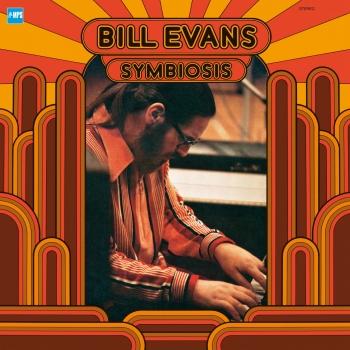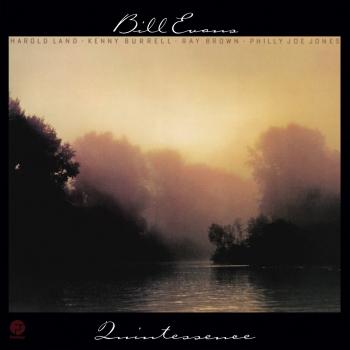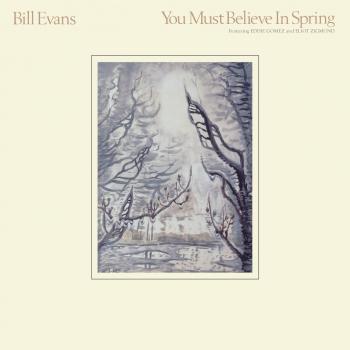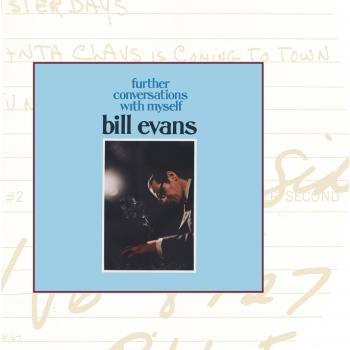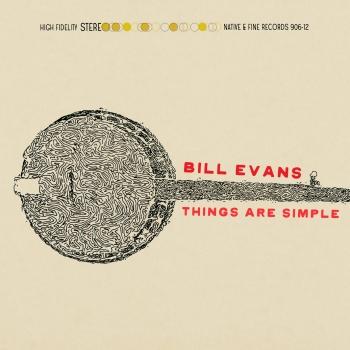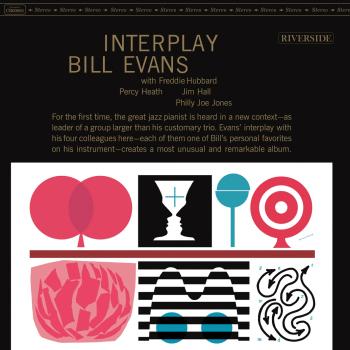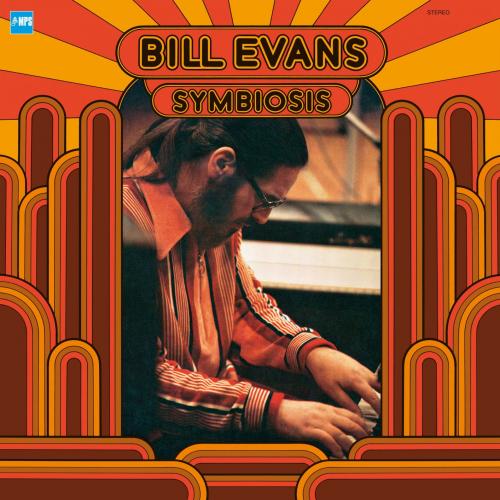
Symbiosis (Remastered) Bill Evans
Album info
Album-Release:
1974
HRA-Release:
27.10.2017
Album including Album cover
- Symbiosis, 1st Movement:
- 1 Moderato. Various Tempi, Pt. 1 07:55
- 2 Moderato. Various Tempi, Pt. 2 05:16
- 3 Moderato. Various Tempi, Pt. 3 11:50
- Symbiosis, 2nd Movement:
- 4 Largo - Andante - Maestoso - Largo, Pt.1 09:13
- 5 Largo - Andante - Maestoso - Largo, Pt. 2 06:46
Info for Symbiosis (Remastered)
Bill Evans: leader of one of most influential trios in jazz history, invaluable contributor to the model explorations on Miles Davis’ Kind of Blue. Miles said it best: “Bill had this quiet fire that I loved on piano. The way he approached it, the sound he got was like crystal notes or sparkling water cascading down from some clear waterfall.” Klaus Ogerman: one of the most prolific 20th century arranger-composers, at home in every style – rock, pop, jazz, classical. Worked with Sinatra, Jobim, 2010 Emmy winner with Diane Krall. Symbiosis: Ogerman’s potent melding of contemporary classical and jazz with NY Philharmonic players, top jazz musicians, and the Bill Evans Trio. Classic Evans in an unusual setting.
„Symbiosis, recorded in 1974 for the German record label MPS (since available on Verve/Polyram, currently out-of-print but available from these sellers) is a superbly performed and beautifully recorded project, despite being one of Bill Evans’ more overlooked and vastly underrated albums. In the fusion-intensive years of the early 1970s, the emphasis in the jazz media -- and especially the record companies, was on musicians who involved themselves with electric music and jazz-rock. These were heady times with new sounds and then-upcoming new talents like Chick Corea, Herbie Hancock, Mahavishnu, Jean-Luc Ponty, Weather Report, et al, garnering the attention of jazz critics. It was the day of new electric keyboards and often exotic instrumentation. These were increasingly difficult times for straight ahead jazz musicians of stature and “name” artists like Bill Evans were no exception. Symbiosis seemed to come in under the radar, and was simply not given much marketing effort or critical attention. But it is a recording that deserves far more scrutiny than it’s received, even among serious Evans fans. Claus Ogerman composed and orchestrated the work with Evans in mind as keyboard soloist. He had worked with Bill on two previous albums. The first in 1963 (the strictly commercial “V.I.P.s Theme…”) and in 1965 (Bill Evans with Symphony Orchestra). Symbiosis is harmonically and rhythmically adventurous, and an often hauntingly gorgeous work in two movements.
The first movement is in three sections, but is a unified whole. It opens with woodwinds as the tight-knit ensemble bounces through the long, knotty eighth-note configurations here, with a nice taste of mid-fifties George Russell in the voicings. In fact we don’t even hear the piano until about two minutes in, when the trio (Eddie Gomez on bass and Marty Morell on drums) enters. They run through some inventive harmonic territory as they roll along, further developing the medium-up paced swing. Bill sounds in good form, his lines clean and melodic. It all draws you in, but the third section of the first movement, after some percussive Latin-feel from the orchestra, the real treats begin. Bill plays long, inventive and often fast- moving lines on electric piano that catch your ear with their shimmering beauty and complexity. He works over a gentle, lilting swing with Ogerman’s sweet but surprisingly muscular strings backing him. Evans’ musical logic is impeccable here, as usual, as the chord structure is strewn with lots of challenging whole -tone and diminished harmonies. It is a lengthy section, and as Bill scampers freely across his Fender-Rhodes, weaving in, around and through the complex yet smooth harmonic movement, one marvels at how he keeps the interest going. But he makes it all sound easy and almost inevitable. Soon after, this rhythm seems to ebb away, and we then hear the playful side of Bill as he alternates staccato jabs on both keyboards as the section closes.
In the next part, Ogerman writes lush but not maudlin strings (and a few flutes) in dense often poly-chordal combinations underneath -- creating a perfect cushion for the pianist’s swirling right-hand lines. The sleek Latin rhythms return (this time with saxes alternating various two and four- bar phrases), until a recapitulation of the chordal theme returns, this time against a C pedal tone. But there’s more, as the trio returns on its own, smoother than silk, with the earlier thematic material now in recapitulation. The Rhodes fits in particularly well in the Symbiosis’ framework. It is often used as punctuation at the end of a written ensemble phrase, or as a smooth and dreamy ensemble texture. Evans’ choices as to when to use the Rhodes or the Steinway are wise indeed, throughout, and with great sensitivity towards integrating the parts seamlessly within the composition. It takes a wise pianist to distinguish between serving the composition as an effective ensemble player, and yet putting one’s personal stamp on it, as Bill does so skillfully here. If you’re listening carefully, you’re drawn into the work itself, always aware of Ogerman’s substantial compositional skill on its own terms --yet never losing the sense that out front, it’s Bill Evans being Bill Evans. I mention this merely since this is almost exactly opposite of the sense one gets listening to the ambitious, yet ultimately abysmal “Living Time” suite he recorded with George Russell’s Orchestra two years prior.
Ahh, but the best has yet to begin! The second movement alone is worth the price of the CD itself. Evans begins alone on piano in B minor, beginning with a lovely, simple three note theme (D down to F#, then G), and as it ever-so-slowly develops a note at a time in a scale motion, its naked simplicity - and how the melancholy harmonies open up --is breathtaking. ( If you’ve ever seen the popular 2005 Paul Giamatti film “Sideways” – a tiny part of this very opening section was used at a critical plot juncture in the film, and the placement of it at that moment -- at the end of a touching conversation in the film--was revealing and dramatic. And yes, it is this recording that was featured, and Bill’s piano that captures that bittersweet movie moment so well.)
After a few tender expositional phrases, Ogerman’s signature strings return, in a profoundly mature restatement, until Bill’s chords mingle with the ensemble, followed again by just the trio, gently moving the section along. Eddie Gomez plays intelligently and with elegant restraint, once again anticipating the pianist’s phrases and spaces so well. This whole little sub-section by itself would have been considered a stellar performance on any Evans trio album of the period. When the strings do return, its just glorious, but there is a bit of an obvious tape edit that is quite audible over quality headphones. Yet the seamlessness of Ogerman’s writing here, with its shifting colors --with Evans doing octaves --makes up for it.
The valedictory-sounding Andante of this second movement (track 4) has more orchestral prominence than keyboard, and builds in an almost Mahler-esque grandiosity, as the pianist cleanly plays the scored single-line part. The march-like quality of the music may be somewhat off-setting here for a little bit, until you start to pay close attention to all the richness of Ogerman’s underscoring. The piece concludes triumphantly, and one thinks it’s all over, but then the sweet serentity of that exquisite solo three-note piano figure returns, and over Bill’s heartfelt playing, a sweet-cream orchestral passage lilts us to the real close of the work -- as Evans’ gently cascading and sparkling fifths coming down from the upper register to remind us of what we heard before in the piece, and what we came for in the first place. (Jan Stevens)
Bill Evans, Piano, Steinway, Fender-Rhodes
David Nadien, Concertmaster
Eddie Gomez, bass
Wally Kane, bassoon
Danny Bank, bass clarinet
Ron Janelly, bass clarinet
Ralph McDonald, congas
Donald MacCourt, double bass
Marty Morell, drums
Bill Slapin, flute
Don Hammond, flute
Hubert Laws, flute
Al Richmond, French Horn
Brooks Tillotson, French Horn
Earl Chapin, French Horn
James Buffington, French Horn
Pete Gordon, French Horn
Ray Alonge, French Horn
George Marge, oboe
Phil Bodner, oboe
Dave Carey, percussion
Doug Allen, percussion
George Devens, percussion
Harvey Estrin, alto saxophone
Jerry Dodgion, alto saxophone
Phil Woods, alto saxophone
Walt Levinsky, alto saxophone
Paul Faulise, bass trombone
Tommy Mitchell, bass trombone
Urbie Green, tenor trombone
Bernie Glow, trumpet
Johnny Frosk, trumpet
Marky Markowitz, trumpet
Marvin Stamm, trumpet
Mel Davis, trumpet
Victor Paz, trumpet
Don Butterfield, tuba
Recorded February 11, 12 and 14th 1974 at Columbia Recording Studios, New York City
Produced by Helen Keane
Digitally remastered
Bill Evans
is an internationally recognized five-string banjo life force. As a performer, teacher, writer and composer, he brings a deep knowledge, intense virtuosity and contagious passion to all things banjo, with thousands of music fans and banjo students from all over the world in a music career that now spans over thirty-five years.
Bill's banjo artistry is best experienced in live performance and on his recordings Fine Times At Fletcher's House with Fletcher Bright (2013), In Good Company (2012), let's do something with Megan Lynch (2009), Bill Evans Plays Banjo (2001) and Native and Fine (1995). Bill successfully bridges traditional and contemporary sounds and playing techniques, creating a new music that is firmly within the bluegrass tradition but draws upon a broad knowledge of classical, jazz and world music, drawing upon his experiences as a graduate student in Music at the University of California, Berkeley and as the associate director of the International Bluegrass Music Museum.
Bill is also an expert player of mid-19th century minstrel banjo and late 19th and early 20th century classic banjo styles, authentically performing these styles on historical instruments. He brings all of these diverse musical performing interests together in his solo concert The Banjo in America.
In the last two years, Bill has toured throughout the United States, Canada, England, and Germany and toured Russia for the U. S. State Department. Recent appearances include A Prairie Home Companion with Garrison Keillor and performances with the San Francisco Symphony. From festival to folk society stages, to universities and performing arts centers, The Banjo in America has earned standing with a dazzling display of banjo artistry of unparalleled historical depth geared towards entertaining general audiences.
Bill is the author of Banjo For Dummies, the most popular banjo book in the world. Banjo For Dummies is now in its second edition and has been translated into French and Portuguese. This year, Bill is preparing a companion volume Bluegrass Banjo For Dummies. In addition, Bill hosts six critically acclaimed instructional DVDs for AcuTab Publications, Homespun Tapes and the Murphy Method and he is also the co-author of Mel Bay’s best-selling Parking Lot Pickers Songbook: Banjo Edition.
With banjo legend Sonny Osborne, Bill hosts the NashCamp Banjo Camp each fall in Fairview, Tennessee. Now in its 13th year, this camp is the premiere bluegrass banjo camp in the world and has featured J. D. Crowe, Jens Kruger, Bill Emerson, Ron Block, Kristin Scott Benson, Rob McCoury, Tony Trischka, Alan Munde, Ned Luberecki, Charlie Cushman, Pete Wernick and Frank Neat, among others.
Bill has also been a mainstay at many other banjo and bluegrass music camps over the last fifteen years, including multiple appearances at Sore Fingers Bluegrass Week (England), Bluegrass Camp Munich (Germany), the Midwest Banjo Camp (Michigan), Steve Kaufman’s Acoustic Music Camp (Tennessee) and the California Bluegrass Association’s Music Camp.
Bill has probably taught more one-on-one banjo lessons than anyone else in the world. His list of students is impressive: Chris Pandolfi (The Infamous Stringdusters), Jayme Stone, Greg Liszt (Crooked Still, the Deadly Gentlemen), Wes Corbett and Erik Yates (Hot Buttered Rum.) However, Bill is equally adept at instructing the older adult learner whose goal is to have fun in a jam session or local band.
At any one time in his home near Richmond, California, Bill teaches between forty and sixty students, in addition to maintaining a steady international touring schedule. In addition, Bill teaches the most popular bluegrass ensemble classes in the San Francisco Bay Area at the Freight and Salvage Coffeehouse and he is on the faculty of the California Jazz Conservatory.
This album contains no booklet.









